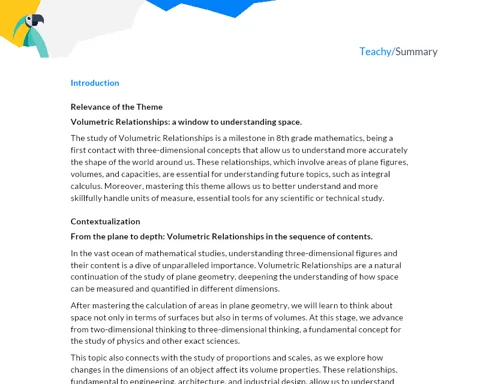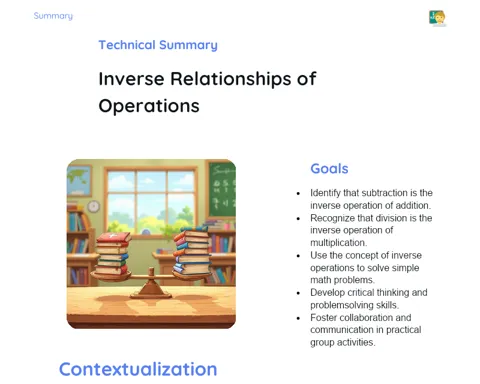Introduction
Relevance of the Theme
Understanding the relationship between perimeter and area is essential for Mathematics, as they are fundamental concepts in the study of geometry. They are the basis for more advanced concepts, such as Measure Theory and Fractal Geometry. Additionally, these concepts have practical applications in various areas, including architecture, civil engineering, graphic design, and arts.
Contextualization
Within the mathematics curriculum, the discussion about the relationship between perimeter and area occurs in the scope of Plane Geometry. Plane Geometry is the basis for many other topics in Mathematics, and understanding its concepts is crucial for advancing in mathematical studies. Furthermore, the study of perimeter and area is a preparation for calculus studies, specifically in understanding the concept of limit, which is fundamental in Differential and Integral Calculus.
Theoretical Development
Components
-
Perimeter: It is the sum of the measures of the sides of a polygon. In the case of a circle, the perimeter is known as circumference. We can understand the perimeter as the measure of the outline of a flat figure.
-
Area: It is the measure of the internal surface of a flat figure. It is the amount of space that the figure occupies. The unit of measure for the area depends on the units of measure used for the dimensions of the figure. For example, if the figure is a square with a side of 3 meters, the area will be 9 square meters.
-
Relationship between Perimeter and Area: The relationship between perimeter and area is complex and varied. There is no general formula for this relationship, as it depends on the type of figure in question. However, we can state that the larger the area of a figure, the larger its perimeter tends to be. However, not always a larger area implies a larger perimeter, this is due to the possibility of irregular shapes.
Key Terms
-
Polygon: It is a closed flat figure formed by line segments. Each segment is a side of the polygon, and two consecutive sides of the polygon meet at a vertex.
-
Circle: It is a set of points in the plane equidistant from a fixed point, called the center. The perimeter of a circle is known as circumference and its area can be calculated using the formula A = πr², where A is the area and r is the radius of the circle.
Examples and Cases
-
Square and Rectangle: Two polygons with distinct properties. The square is a special rectangle with all sides equal. When comparing squares and rectangles with the same area, we can notice that the rectangle has a larger perimeter. This is because the sides of the rectangle can vary in length, but the sum of the lengths of the sides is always greater than that of the square.
-
Circles and Regular Inscribed Polygons: Regular polygons inscribed in circles have interesting properties of the relationship between perimeter and area. For example, considering a regular pentagon inscribed in a circle, if we increase the area of the pentagon while maintaining its regularity, the radius of the circle inscribed in the pentagon will also increase, as well as the perimeter of the circle.
-
Circles and Squares: Among all flat figures with the same area, the circle has the smallest perimeter. This is a result known as the 'isoperimetry of the circle'. It shows that for a given area value, the circle has the smallest amount of lines on its outline, making it an efficient shape for storing or transporting materials.
Detailed Summary
Relevant Points
-
Defined Perimeter and Area: Understanding these fundamental concepts is crucial. The perimeter is the measure of the outline of a figure, while the area is the measure of the internal surface.
-
Polygons and Circles: Polygons are closed flat figures with straight sides, while a circle is a set of points equally distant from the center. The area of a circle can be calculated using the formula A = πr².
-
Relationship between Perimeter and Area: There are several possible scenarios for the relationship between perimeter and area. For example, when comparing squares and rectangles with the same area, the rectangle always has a larger perimeter due to how its sides can vary.
Conclusions
-
Diversity of Shapes: The study of the relationship between perimeter and area demonstrates the diversity of possible shapes within a certain area size. Different shapes can have the same area size, but their perimeters can vary significantly.
-
Efficiency of the Circle: The circle is the figure with the smallest perimeter among all figures with the same area. This is because the circle is the shape that most efficiently uses its outline to occupy an area.
Suggested Exercises
-
Perimeter Comparison: Given two squares, one with a side measuring 4 units and another with a side measuring 6 units, compare their perimeters. What can you say about the relationship between their sides and perimeters?
-
Area Calculation: Calculate the area and perimeter of a rectangle with sides measuring 7 units and 9 units, respectively. Then, find a rectangle with the same area but with different perimeter lengths.
-
Circle vs Square: Find a square and a circle with the same area. Compare their perimeters. What can you conclude about the relationship between the perimeter of these two figures?



